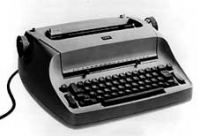IBM Selectric I Typewriter
In 1961 IBM introduced a revolutionary electric typewriter, the Selectric I, which replaced the standard typebars with a moving interchangeable spherical "golf ball" printing element, while the carriage remained fixed. Development began in 1951, and the sculptured housing was designed starting 1959 by Eliot Noyes, FIDSA (see below). In 1971, a later version, Selectric II, entered the market. By 1975 Selectrics accounted for about 75 percent of the US electric typewriter market, which soon after went south when typewriters were increasingly replaced by personal computers.
Typewriters were developed in 1872 by Christopher Latham Sholes (1819-1890) and James Densmore. They also developed the QUERTY keyboard to slow down the typing speed so that the mechanical linkages (typebars) would not jam. In 1932, Dr. August Dvorak proposed a more practical typewriter keyboard with the most-used letters in the middle bar, but opposition to change by professional typists and teachers prevented its adoption.
In 1932, the Olivetti Company in Italy introduced the first portable typewriter, the MPI. It was also the first to be "styled", by Aldo Magnelli and his brother,Roberto , an abstract artist.
In 1935, Ollivetti's Studio 42 typewriter, designed by Alexander (Xanti) Schavinsky, a former Bauhaus student, and architects Luigi Figini and Gino Pollini, debuted. It set the typeform of the modern typewriter. That same year, the Swiss firm of Ernest Paillard introduced the first inexpensive portable typewriter, the Hermes, engineered by Giuseppe Prezioso. It became the most popular choice of journalists and reporters.
The electric typewriter was invented in 1920 by James Smathers, but IBM marketed the first commercially successful one in 1935.
In 1936, Olivetti engaged Italian industrial designer Marcello Nizzoli (1887-1969) for all its typewriter design. He designed the Lexicon 80 in 1948, and the famous Lettera 22 in 1950. In 1956, he designed the acclaimed Mirella sewing machine by Necchi of Italy, which won the 1957 Compasso d'Oro. Nizzoli headed design at Olivetti into the 1960s.
In 1958, Ollivetti introduced the Tekne 3 electric typewriter, designed by Ettore Sottsass Jr. (b. 1917), a leadingpost-war Italian architect and industrial designer who worked briefly with George Nelson in 1956, and then started with Olivetti.
Eliot Fette Noyes, FIDSA, (1910-1977) was a US architect and industrial designer who was born in Boston, studied architecture at Harvard (1932-1938) and was employed by Marcel Breuer and Walter Gropius after graduation. He worked as a curator at the Museum of Modern Art and was appointed director of the new department of industrial design there in 1940. In 1941 he organized a competition for the museum to discover imaginative designers for contemporary living. Prizes were awarded to Charles Eames (1907-1978) and Eero Saarinen (1910-1961), both on the faculty of Cranbrook Academy, for innovative furniture designs, which were then exhibited by the museum as "Organic Design in Home Furnishings."
After serving in the air force during the war, Noyes was design director with Norman Bel Geddes. When Bel Geddes' office closed in 1947, one of the unfinished projects was a Model A electric typewriter for IBM.
Noyes opened his own office and finished the job for IBM. He was retained in 1948 by Thomas J. Watson Jr. for IBM product design and in 1956 to develop a unique IBM corporate style and image similar to Olivetti, IBM's key competitor. He did so with help from Paul Rand, Marcel Breuer and Charles Eames.
In 1960, based on his highly successful work for IBM, Noyes was retained by Westinghouse to repair their deteriorating image, again using Paul Rand for graphics.
